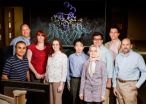EARTH: D-Day's legacy sands
2011-06-01
(Press-News.org) Alexandria, VA –Next week marks the 67th anniversary of D-Day, when the Allies stormed the beaches at Normandy, France, and changed the face of World War II. Not much evidence of the war remains in Normandy: a few dilapidated relics, a cemetery, a war memorial. But something else was left behind that cannot be seen by the naked eye: shrapnel and iron and glass beads left over from the D-Day invasions in 1944.
Two geologists visited Omaha Beach in 1988 and collected samples of the sand. Upon returning to their labs, they examined the sand under microscopes and discovered the remnants of the war. As they explain in the June feature "D-Day's Legacy Sands," it is not surprising that shrapnel was initially added to the sands at Omaha Beach, but it is surprising that it has survived this long.
Learn more about Omaha Beach's sand surprises, and read other stories on topics such as what scientists are learning from the Japan and New Zealand earthquakes, what researchers are doing to get ahead of the mysterious disease that's killing bats by the millions, and how NASA's MESSENGER mission to Mercury is bringing much-needed good news to the space agency, all in the June issue. Plus, don't miss the story about the new rover that will be exploring beneath Antarctica's ice.
INFORMATION:These stories and many more can be found in the June issue of EARTH, now available digitally (http://www.earthmagazine.org/digital/) or in print on your local newsstands.
For further information on the June featured article, go to http://www.earthmagazine.org/earth/article/451-7db-5-1b .
Keep up to date with the latest happenings in earth, energy and environment news with EARTH magazine, available on local newsstands or online at http://www.earthmagazine.org/. Published by the American Geological Institute, EARTH is your source for the science behind the headlines.
END
ELSE PRESS RELEASES FROM THIS DATE:
2011-06-01
In the 30 years since the first reported cases of a mysterious illness now known as AIDS, researchers have made extraordinary advances in understanding, treating and preventing the disease. Now the challenge, according to experts at the National Institute of Allergy and Infectious Diseases (NIAID), part of the National Institutes of Health, is to build on those successes to control and, ultimately, end the HIV/AIDS pandemic.
In an article published online today by the Annals of Internal Medicine, Anthony S. Fauci, M.D., NIAID Director, and Carl W. Dieffenbach, Ph.D., ...
2011-06-01
Each time you see a person that you know, your brain rapidly and seemingly effortlessly recognizes that person by his or her face.
Until now, scientists believed that only a couple of brain areas mediate facial recognition. However, Carnegie Mellon University's Marlene Behrmann, David Plaut and Adrian Nestor have discovered that an entire network of cortical areas work together to identify faces. Published in the current issue of the Proceedings of the National Academy of Sciences (PNAS), their findings will change the future of neural visual perception research and ...
2011-06-01
The following highlights summarize research papers that have been recently published in Geochemistry, Geophysics, Geosystems (G-Cubed), Geophysical Research Letters (GRL), the Journal of Geophysical Research-Atmospheres (JGR-D), the Journal of Geophysical Research-Biogeosciences (JGR-G), the Journal of Geophysical Research-Space Physics (JGR-A), Paleoceanography (PA), and Water Resources Research (WRR).
1. Analyzing subsurface oil and gas intrusions from Gulf spill
After the Deepwater Horizon blowout in 2010, hydrocarbons were released into the Gulf of Mexico. These ...
2011-06-01
CAMDEN – If you think that you're using humanely produced eggs for your omelets or deviled eggs, think again. Egg companies recognize that most Americans care about the welfare of farmed animals and many market their eggs with labels claiming the hens were treated well. But a Rutgers–Camden law professor warns that many of the animal welfare claims on egg cartons aren't all that they're cracked up to be.
Sheila Rodriguez, a clinical associate professor at the Rutgers School of Law–Camden, asserts that food consumers have a right to know how farm animals are raised and, ...
2011-06-01
CHAMPAIGN, lll. — Blood clotting is a complicated business, particularly for those trying to understand how the body responds to injury. In a new study, researchers report that they are the first to describe in atomic detail a chemical interaction that is vital to blood clotting. This interaction – between a clotting factor and a cell membrane – has baffled scientists for decades.
The study appears online in the Journal of Biological Chemistry.
"For decades, people have known that blood-clotting proteins have to bind to a cell membrane in order for the clotting reaction ...
2011-06-01
A team of Scripps Research Institute scientists has found a key biological mechanism underpinning the transition to alcohol dependence. This finding opens the door to the development of drugs to manage excessive alcohol consumption.
"Our focus in this study, like much of our lab's research, was to examine the role of the brain's stress system in compulsive alcohol drinking driven by the aversive aspects of alcohol withdrawal," said Scripps Research Associate Professor Marisa Roberto, Ph.D., senior author of the study.
"A major goal for this study," added Research Associate ...
2011-06-01
In the treeless, flat Prairie, you'd think a city would provide a good home for bats who like to snuggle up and roost in trees and buildings. But researchers at the University of Calgary made the surprising discovery that the urban landscape is far from ideal for these animals.
"I was really surprised," says Dr. Joanna Coleman, a sessional lecturer and recent PhD graduate in biological sciences at the University of Calgary and lead author of the study. "I fully expected bats to benefit from the expected increase in availability of roosts and food – insects -- in the city. ...
2011-06-01
PHILADELPHIA — Engineering structures on the smallest possible scales — using molecules and individual atoms as building blocks — is both physically and conceptually challenging. An interdisciplinary team of researchers at the University of Pennsylvania has now developed a method of computationally selecting the best of these blocks, drawing inspiration from the similar behavior of proteins in making biological structures.
The team was led by postdoctoral fellow Gevorg Grigoryan and professor William DeGrado of the Department of Biochemistry and Biophysics in Penn's Perelman ...
2011-06-01
The #1 ranked WordPress Training company announces they are providing private 1-ON-1 WordPress Training to individuals wanting t tailor their wordpress training needs to their own pace and also focus the training on THEIR OWN WEBSITES.
That's right, if you're looking for wordpress training from WP professionals now you can have the training or help you require tailored to YOUR needs or have the wordpress training professional assist you in teaching you how to customize or set-up YOUR specific website.
Aperio has found through it's over 1,500 students whom have taken ...
2011-06-01
Researchers at the University of California, San Diego, the Medical University of South Carolina and American Life Science Pharmaceuticals of San Diego have demonstrated that oral administration of a cysteine protease inhibitor, E64d, not only reduces the build-up of β-amyloid (Aβ) in the brains of animal models for Alzheimer's disease, but also results in a substantial improvement in memory deficit.
A paper detailing the findings has been published as an early online version and is scheduled for publication in the September 6 issue of the Journal of Alzheimer's ...
LAST 30 PRESS RELEASES:
[Press-News.org] EARTH: D-Day's legacy sands



